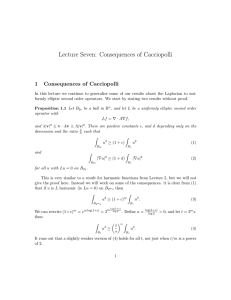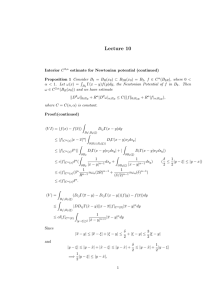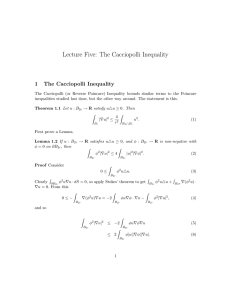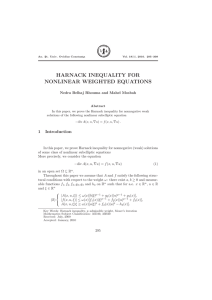Electronic Journal of Differential Equations, Vol. 2015 (2015), No. 211,... ISSN: 1072-6691. URL: or
advertisement
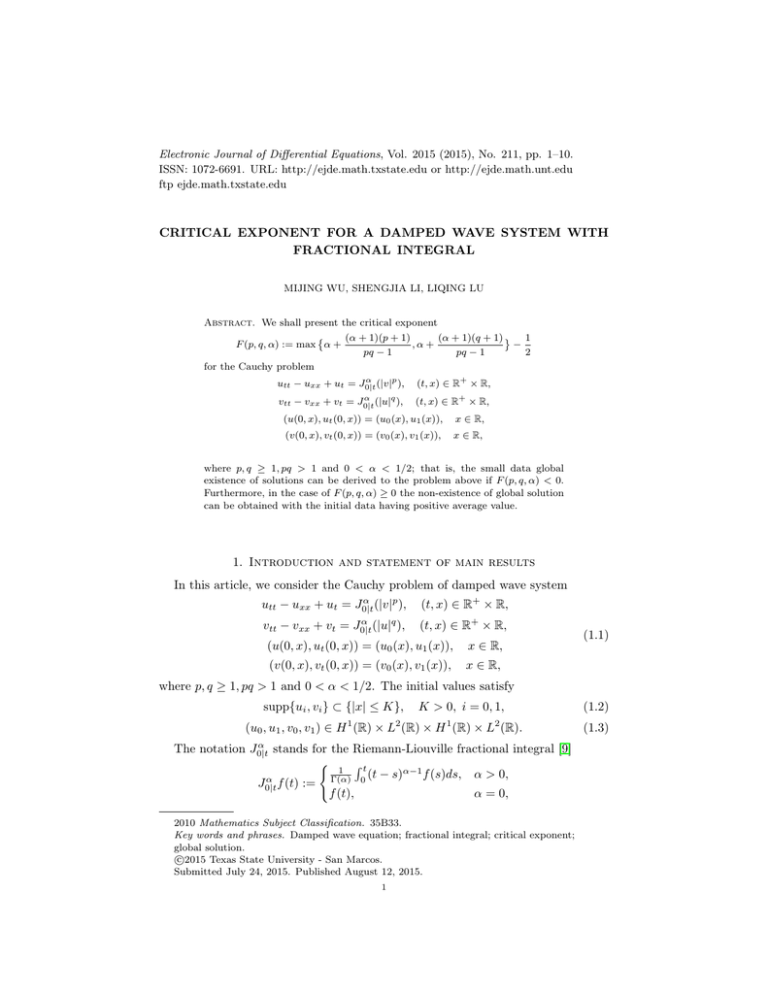
Electronic Journal of Differential Equations, Vol. 2015 (2015), No. 211, pp. 1–10.
ISSN: 1072-6691. URL: http://ejde.math.txstate.edu or http://ejde.math.unt.edu
ftp ejde.math.txstate.edu
CRITICAL EXPONENT FOR A DAMPED WAVE SYSTEM WITH
FRACTIONAL INTEGRAL
MIJING WU, SHENGJIA LI, LIQING LU
Abstract. We shall present the critical exponent
˘
(α + 1)(p + 1)
(α + 1)(q + 1) ¯ 1
F (p, q, α) := max α +
,α +
−
pq − 1
pq − 1
2
for the Cauchy problem
α
utt − uxx + ut = J0|t
(|v|p ),
(t, x) ∈ R+ × R,
α
J0|t
(|u|q ),
(t, x) ∈ R+ × R,
vtt − vxx + vt =
(u(0, x), ut (0, x)) = (u0 (x), u1 (x)),
x ∈ R,
(v(0, x), vt (0, x)) = (v0 (x), v1 (x)),
x ∈ R,
where p, q ≥ 1, pq > 1 and 0 < α < 1/2; that is, the small data global
existence of solutions can be derived to the problem above if F (p, q, α) < 0.
Furthermore, in the case of F (p, q, α) ≥ 0 the non-existence of global solution
can be obtained with the initial data having positive average value.
1. Introduction and statement of main results
In this article, we consider the Cauchy problem of damped wave system
α
utt − uxx + ut = J0|t
(|v|p ),
(t, x) ∈ R+ × R,
α
vtt − vxx + vt = J0|t
(|u|q ),
(t, x) ∈ R+ × R,
(u(0, x), ut (0, x)) = (u0 (x), u1 (x)),
x ∈ R,
(v(0, x), vt (0, x)) = (v0 (x), v1 (x)),
x ∈ R,
(1.1)
where p, q ≥ 1, pq > 1 and 0 < α < 1/2. The initial values satisfy
supp{ui , vi } ⊂ {|x| ≤ K},
1
2
K > 0, i = 0, 1,
1
2
(u0 , u1 , v0 , v1 ) ∈ H (R) × L (R) × H (R) × L (R).
α
The notation J0|t
stands for the Riemann-Liouville fractional integral [9]
(
Rt
1
(t − s)α−1 f (s)ds, α > 0,
α
J0|t f (t) := Γ(α) 0
f (t),
α = 0,
2010 Mathematics Subject Classification. 35B33.
Key words and phrases. Damped wave equation; fractional integral; critical exponent;
global solution.
c
2015
Texas State University - San Marcos.
Submitted July 24, 2015. Published August 12, 2015.
1
(1.2)
(1.3)
2
M. WU, S. LI, L. LU
EJDE-2015/211
for f ∈ Lp (0, T )(1 ≤ p ≤ ∞) and Γ(·) is the Euler gamma function.
In recent decades, nonlinear hyperbolic equations and systems have been studied
extensively (see, for example, [4, 5, 9, 10, 11, 18, 19] and the rich references therein).
Todorova and Yordanov [17] considered the semilinear wave equation
utt − ∆u + ut = |u|p ,
u(x, 0) = u0 (x),
(t, x) ∈ (0, ∞) × Rn ,
x ∈ Rn ,
ut (x, 0) = u1 (x),
(1.4)
and proved that the critical exponent of (1.4) is pc (n) = 1 + 2/n. More precisely, if
p > pc (n) there exists a unique global solution of (1.4) for sufficiently small initial
data, while, if 1 < p < pc (n) any solution with positive initial data must blow up in
finite time. Later Zhang [20] proved that the exponent 1 + 2/n belongs to the blow
up region. Fino [2] considered the damped wave equation with nonlinear memory
term
α
utt − ∆u + ut = J0|t
(|u|p )(t).
(1.5)
The existence of global solutions and the asymptotic behavior of small data solutions to (1.5) as t → ∞ were established when 1 ≤ n ≤ 3. If p > 1+2(1+α)/(n−2α),
the blow up result was also derived under some positive data in any dimensional
space. Comparing the results of [17] with that of [2], we derive that the fractional
α
integral J0|t
has an influence on the solution. The problems with the fractional
integral term are interesting.
The problem (1.1) with α = 0 can be considered as the following weakly coupled
system
utt − ∆u + ut = |v|p ,
(t, x) ∈ (0, ∞) × Rn ,
vtt − ∆v + vt = |u|q ,
(t, x) ∈ (0, ∞) × Rn ,
(u(0, x), ut (0, x)) = (u0 (x), u1 (x)),
x ∈ Rn ,
(v(0, x), vt (0, x)) = (v0 (x), v1 (x)),
x ∈ Rn .
(1.6)
Sun and Wang [16] considered (1.6) and obtained the critical exponent
F (p, q, n) := max
p+1 q+1 n
,
− .
pq − 1 pq − 1
2
The authors proved that if F (p, q, n) < 0, there exists a unique global solution of
(1.6) with suitably small initial data for n = 1 or n = 3, and if F (p, q, n) ≥ 0,
any solution of (1.6) with initial data having positive integral values does not exist
globally for any n ≥ 1. Based on some conditions on nonlinear term, the asymptotic
behavior of solutions of (1.6) was considered in [12]. Recently, Kenji and Yuta
[13] showed that the number F (p, q, n) is the critical exponent of (1.6) for any
dimensional space.
Motivated by the work of [2] and [16], we aim at determining the critical exponent
of (1.1). The global result is proved by the weighted energy method (see [17]). For
the non-existence of a global solution, we shall use the test function method (see
[2]). Our basic definition of the solution to problem (1.1) is the following.
Definition 1.1. Let T > 0. We say that a pair of functions (u, v) in Lq ((0, T ),
Lqloc (R)) × Lp ((0, T ), Lploc (R)) is a weak solution of the Cauchy problem (1.1) with
EJDE-2015/211
CRITICAL EXPONENT
3
the initial data (ui , vi ) ∈ [Lloc (R)]2 if (u, v) satisfies
Z TZ
u(ϕtt − ϕxx + ϕt ) dx dt
Rn
T Z
0
Z
=
Rn
0
Z
T
α
(J0|t
|v|p )ϕ dx dt
Z
Z
+
u0 (x)(ϕ(0, x) − ϕt (0, x))dx,
u1 (x)ϕ(0, x)dx +
Rn
Rn
Z
v(ϕtt − ϕxx + ϕt ) dx dt
0
Z
Rn
T Z
=
0
Rn
α
|u|q )ϕ dx dt +
(J0|t
Z
Z
v0 (x)(ϕ(0, x) − ϕt (0, x))dx,
v1 (x)ϕ(0, x)dx +
Rn
Rn
(1.7)
for all compactly supported test functions ϕ ∈ C 2 ([0, T ] × R) with ϕ(T, ·) = 0 and
ϕt (T, ·) = 0. If T = ∞, we say that (u, v) is a global weak solution of (1.1).
We remark that the above definition of a weak solution is a very weak form
which will be used in the proof of non-existence of a global solution. However, to
prove the global result we need a much stronger form. We have the following local
existence result.
Proposition 1.2. Let T > 0. Under assumptions (1.2) and (1.3), there exists a
unique solution (u, v) ∈ X(T ) × X(T ) for (1.1) satisfying
supp{u, v} ⊂ B(t + K) = {(t, x) : |x| ≤ t + K}, K > 0
where X(T ) = C([0, T ); H 1 (R)) ∩ C 1 ([0, T ); L2 (R)).
Using [6, Proposition 2.3] and [2, Proposition 1], the local solvability and uniqueness of (1.1) can be established by a standard estimation and compactness theory.
Denote k·kr and k·kH m the norms of Lr (R) and H m (R) respectively. Throughout
this article, we use C to stand for a generic positive constant which may be different
from line to line. Set
(α + 1)(p + 1)
(α + 1)(q + 1) 1
F (p, q, α) := max α +
,α +
− .
pq − 1
pq − 1
2
Based on Proposition 1.2, our main results read as follows
Theorem 1.3. Assume that (1.2) and (1.3) hold. If F (p, q, α) < 0, then there is
a small constant ε such that under the conditions
I0,u = ku0 kH 1 + ku0 k1 + ku1 k2 + ku1 k1 < ε,
I0,v = kv0 kH 1 + kv0 k1 + kv1 k2 + kv1 k1 < ε,
(1.8)
problem (1.1) admits a unique global solution
(u, v) ∈ [C((0, ∞); H 1 (R)) ∩ C 1 ((0, ∞); L2 (R))]2 .
Moreover,
kDu(t)k2 ≤ (1 + t)−
(α+1)(p+1)
− 14
(pq−1)
(α+1)(q+1)
− (pq−1) − 14
kDv(t)k2 ≤ (1 + t)
where Du = (ut , ux ).
,
t → ∞,
,
t → ∞,
(1.9)
4
M. WU, S. LI, L. LU
EJDE-2015/211
Theorem 1.4. Assumed that (1.2), (1.3) hold and
Z
Z
ui dx > 0,
vi dx > 0, i = 0, 1.
R
(1.10)
R
If F (p, q, α) ≥ 0, then the weak solution (u, v) of (1.1) does not exist globally.
Remark 1.5. F (p, q, α) is the critical exponent of (1.1).
Remark 1.6. If α = 0, F (p, q, α) is consistent with the critical exponent of (1.6)
for n = 1.
The remainder of this paper is organized as follows. In Section 2, some preliminaries are collected. We will prove our global result (Theorem 1.3) in Section 3.
Section 4 is devoted to proving the blow up result (Theorem 1.4).
2. Preliminaries
We shall start this section with some basic definitions and properties on the
Riemann-Liouville fractional calculus. We refer to [7]-[3] for more details.
Let AC[0, T ] denote the space of all absolutely continuous functions on [0, T ].
Then, if f ∈ AC[0, T ], the left-sided and the right-sided Riemann-Liouville fractional derivatives of the function f of order α ∈ (0, 1) are defined by
Z T
1
1−α
α
α
∂t
(s − t)−α f (s)ds.
D0|t
f (t) := ∂t J0|t
f (t), Dt|T
f (t) := −
Γ(1 − α)
t
Set
AC n+1 [0, T ] := {f : [0, T ] → Rtextand∂tn f ∈ AC[0, T ]}.
Then for all f ∈ AC n+1 [0, T ], the following propositions are obtained in [7, 14, 15],
respectively.
Proposition 2.1 ([7]). Let 0 < α < 1 and p ≥ 1. If f ∈ Lp (0, T ),
α
α
(D0|t
J0|t
f )(t) = f (t),
n+α
α
(−1)n ∂tn Dt|T
f = Dt|T
f,
for almost everywhere on [0, T ].
Proposition 2.2 ([15]). Let 0 < α < 1. For every f, g ∈ C([0, T ]) such that
α
α
(D0|t
f )(t), (Dt|T
g)(t) exist and are continuous, the formula of integration by parts
is
Z T
Z T
α
α
(D0|t
f )(t)g(t)dt =
f (t)(Dt|T
g)(t)dt, t ∈ [0, T ].
0
0
Proposition 2.3 ([14]). Set ϕ2 (t) := (1 − t/T )η+ . Then ϕ2 (t) satisfies
α
Dt|T
ϕ2 (t) = CT −η (T − t)η−α
+ ,
α+1
Dt|T
ϕ2 (t) = CT −η (T − t)η−α−1
,
+
α+2
Dt|T
ϕ2 (t) = CT −η (T − t)η−α−2
,
+
and
α
Dt|T
ϕ2 (T ) = 0,
α+1
Dt|T
ϕ2 (T ) = 0,
α
Dt|T
ϕ2 (0) = CT −α ,
α+1
Dt|T
ϕ2 (0) = CT −α−1 .
EJDE-2015/211
CRITICAL EXPONENT
5
Consider the linear damped wave equation
Utt − Uxx + Ut = 0,
(t, x) ∈ (0, ∞) × R,
(U (0, x), Ut (0, x)) = (U0 (x), U1 (x)),
x ∈ R.
(2.1)
When U0 = 0, the unique solution U (t, x) to (2.1) can be denoted by S(t)U1 . Then
the Duhamel’s principle implies the solution to (1.4) solves the integral system
Z t
α
u(t, x) = S(t)(u0 + u1 ) + ∂t (S(t)u0 ) +
S(t − τ )J0|τ
(|v|p )dτ
0
Z t
α
(|v|p )dτ,
= uL +
S(t − τ )J0|τ
0
(2.2)
Z t
α
q
v(t, x) = S(t)(v0 + v1 ) + ∂t (S(t)v0 ) +
S(t − τ )J0|τ (|u| )dτ
0
Z t
α
= vL +
S(t − τ )J0|τ
(|u|q )dτ.
0
The following lemmas will be used in the proof of Theorem 1.3.
Lemma 2.4 ([17, Proposition2.5]). Let m ∈ [1, 2]. Then
k∂tk ∇νx S(t)f k2 ≤ C(1 + t)n/4−n/(2m)−|ν|/2−k (kf km + kf kH k+|ν|−1 ),
T
for each f ∈ Lm (Rn ) H k+|ν|−1 (Rn ).
(2.3)
Lemma 2.5 ([17, Proposition2.4]). Let θ(r) = n(1/2 − 1/r) and 0 ≤ θ(r) ≤ 1, 0 <
δ ≤ 1. If u ∈ H 1 (Rn ) with supp u ⊂ B(t + K), then
keδψ(t,·) ukr ≤ C(1 + t)(1−θ(r))/2 keψ(t,·) ∇ukδ2 k∇uk1−δ
,
2
p
where ψ(t, x) = (t + K − (t + K)2 − |x|2 )/2.
(2.4)
Lemma 2.6 ([1]). Suppose that 0 ≤ θ < 1, a ≥ 0 and b ≥ 0. Then there exists a
constant C > 0 depending only on a, b and θ such that for all t > 0,
Z t
(t − τ )−θ (1 + t − τ )−a (1 + τ )−b dτ
0
− min{a+θ,b}
,
max{a + θ, b} > 1,
C(1 + t)
≤ C(1 + t)− min{a+θ,b} ln(2 + t), max{a + θ, b} = 1,
C(1 + t)1−θ−a−b ,
max{a + θ, b} < 1.
3. Proof of Theorem 1.3
Let Tmax be the maximal existence time of the local solution of (u, v) to the
problem (1.1). Denote
M (t) = sup ((1 + τ )k kDu(τ )k2 + (1 + τ )j kDv(τ )k2 ),
∀t ∈ [0, Tmax ),
(3.1)
0≤τ <t
where k, j will be determined later. We will prove the estimate
M (t) ≤ C(ε + M (t)p + M (t)q ),
∀t ∈ [0, Tmax ),
with C is independent of ε. Taking ε and C1 sufficiently small such that
Cε < C1 ,
2p−1 CM (t)p−1 + 2q−1 CM (t)q−1 < 1,
(3.2)
6
M. WU, S. LI, L. LU
EJDE-2015/211
then as the argument in [4, Proposition 2.1], we find from (3.2) that
M (t) ≤ 2C1 ,
∀t ∈ [0, Tmax ).
We have that
kDu(t)k2 ≤ C(1 + t)−k ,
kDv(t)k2 ≤ C(1 + t)−j ,
∀t ∈ [0, Tmax ),
which imply Tmax = ∞, the solution of (1.1) exists globally in time.
Now, we prove (3.2). From (2.2), we deduce that
Z t
α
kDu(t)k2 ≤ kDuL (t)k2 +
kDS(t − τ )J0|τ
(|v|p )(τ )k2 dτ.
(3.3)
0
Applying Lemma 2.4 with m = 1 and n = 1, we see that
kDuL (t)k2 ≤ CI0,u (1 + t)−3/4 ,
(3.4)
and
Z
t
α
kDS(t − τ )J0|τ
(|v|p )(τ )k2 dτ
Z t
α
α
≤C
(1 + t − τ )−3/4 (kJ0|τ
(|v|p )(τ )k1 + kJ0|τ
(|v|p )(τ )k2 )dτ
0
Z t
Z τ
≤C
(1 + t − τ )−3/4
(τ − s)−(1−α) (kv(s)kpp + kv(s)kp2p )dsdτ.
0
0
(3.5)
0
p
Next, we transform the L norm into a weighted L2p norm. Making use of the
Cauchy inequality and the fact ψ(t, x) ≥ |x|2 /4(t + K) for x ∈ B(τ + K), we have
Z
kv(τ, ·)kpp =
|v(τ, x)|p dx
B(τ +K)
≤
Z
1/2 Z
e−2pδψ(τ,x) dx
B(τ +K)
≤
Z
e2pδψ(τ,x) |v(τ, x)|2p dx
1/2
B(τ +K)
2
e−pδ|x|
/2(τ +K)
dx
1/2
keδψ(τ,·) v(τ )kp2p
B(τ +K)
≤ CK,δ (τ + K)1/4 keδψ(τ,·) v(τ )kp2p ,
(3.6)
where δ > 0. Obviously,
kv(τ, ·)kp2p ≤ (τ + K)1/4 keδψ(τ,·) v(τ )kp2p .
From (3.5)-(3.7), we obtain
Z t
α
kDS(t − τ )J0|τ
(|v|p )(τ )k2 dτ
0
h
ip
≤ C sup (1 + τ )β1 keδψ(τ,·) v(τ )k2p
[0,t)
Z
×
0
t
(1 + t − τ )−3/4
Z
0
τ
(τ − s)−(1−α) (1 + s)−(pβ1 −1/4) dsdτ.
(3.7)
(3.8)
EJDE-2015/211
CRITICAL EXPONENT
7
Taking β1 = (α + 1)(q + 1)/(pq − 1) − 1/4p such that 1/4 < pβ1 < 5/4 and applying
Lemma 2.6, we have
Z t
α
(|v|p )(τ )k2 dτ
kDS(t − τ )J0|τ
0
(3.9)
p
≤ C(1 + t)−k sup (1 + τ )β1 keδψ(τ,·) v(τ )k2p ,
[0,t)
where k = (α + 1)(p + 1)/(pq − 1) + 1/4. To estimate the weighted L2p norm, we
use Lemma 2.5 with r = 2p and n = 1,
keδψ(τ,·) v(τ )k2p ≤ C(1 + τ )(1−θ(2p))/2 kvx k1−δ
keψ(τ,·) vx kδ2
2
≤ C(1 + τ )(1−θ(2p))/2 kDvk2 .
(3.10)
From (3.9), (3.10) and (3.1), we derive that
Z t
p
α
kDS(t − τ )J0|τ
(|v|p )(τ )k2 dτ ≤ C(1 + t)−k sup (1 + τ )β1 +(1−θ(2p))/2−j M (t) .
[0,t)
0
(3.11)
Multiplying (3.3) by (1 + t)k and from (3.4), (3.11), we obtain that
h
ip
(1 + t)k kDu(t)k2 ≤ CI0,u (1 + t)k−3/4 + C sup (1 + τ )β1 +(1−θ(2p))/2−j M (τ ) .
[0,t)
(3.12)
Similarly, we can deduce that
q
(1+t)j kDv(t)k2 ≤ CI0,v (1+t)j−3/4 +C sup (1+τ )β2 +(1−θ(2q))/2−k M (τ ) , (3.13)
[0,t)
where we choose β2 = (α + 1)(p + 1)/(pq − 1) − 1/4q such that 1/4 < qβ2 < 5/4
and get j = (α + 1)(q + 1)/(pq − 1) + 1/4. It can be easily checked that
β1 + (1 − θ(2p))/2 − j = 0,
β2 + (1 − θ(2q))/2 − k = 0,
.
(3.14)
and
k − 3/4 < F (p, q, α) − α, j − 3/4 < F (p, q, α) − α.
As qβ2 < 5/4 and pβ1 < 5/4 imply F (p, q, α) < 0, we have
k − 3/4 < −α,
j − 3/4 < −α.
(3.15)
Combining (3.12)-(3.15), we have (3.2). Theorem 1.3 is proved.
4. Proof of Theorem 1.4
In this section we prove the theorem by contraction. In the following, we assume
that (u, v) is a global weak solution of (1.1).
Set ϕ1 (x) := φl (|x|/R), l 1 with the cut-off function φ(r) satisfying
(
1, 0 ≤ r ≤ 1,
φ(r) =
(4.1)
0, r ≥ 2,
0 ≤ φ(r) ≤ 1,
|φ0 (r)| ≤ C/r,
|φ00 (r)| ≤ C/r,
t/T )η+ ,
(4.2)
and ϕ2 (t) := (1 −
with η 1. The supports of ϕ1 and (ϕ1 )xx are denoted
as B2R and B2R \ BR respectively, where
B2R = {x ∈ R : |x| ≤ 2R},
B2R \ BR = {x ∈ R : R ≤ |x| ≤ 2R}.
8
M. WU, S. LI, L. LU
EJDE-2015/211
Denote
α
ϕ(t, x) := ϕ1 (x)(Dt|T
ϕ2 )(t).
(4.3)
From (4.1)-(4.3) and the Proposition 2.1-2.3, we obtain
T
Z
Z
0
|v(t, x)|p ϕ(x, t) dx dt
B2R
Z
+ T −α
(u1 (x) + u0 (x))ϕ1 (x)dx + T −α−1
Z
u0 (x)ϕ1 (x)dx
B2R
T
Z
Z
=
0
B2R
T Z
Z
B2R
α+2
α+1
uϕ1 (Dt|T
ϕ2 (t) + Dt|T
ϕ2 (t)) dx dt
α
u(ϕ1 )xx (Dt|T
ϕ2 )(t) dx dt,
−
0
Z
0
T
B2R \BR
Z
q
|u(t, x)| ϕ(x, t) dx dt + T
Z
−α−1
+T
v0 (x)ϕ1 (x)dx
B2R
−α
(4.4)
Z
(v1 (x) + v0 (x))ϕ1 (x)dx
B2R
B2R
T
Z
Z
B2R
T Z
Z
α+2
α+1
vϕ1 (x)(Dt|T
ϕ2 (t) + Dt|T
ϕ2 (t)) dx dt
=
0
−
0
B2R \BR
α
v(ϕ1 )xx (Dt|T
ϕ2 )(t) dx dt.
Set
Z tZ
Jp =
0
|v(t, x)|p ϕ(t, x) dx dt,
(4.5)
|u(t, x)|q ϕ(t, x) dx dt.
(4.6)
B2R
Z tZ
Jq =
0
B2R
From (1.10) and (4.4), we have
T
Z
Z
B2R
T Z
Z
Jp ≤ C
0
2+α
1+α
|u|ϕ1 (Dt|T
ϕ2 (t) + Dt|T
ϕ2 (t)) dx dt
(4.7)
+C
B2R \BR
0
α
|u(ϕ1 )xx |(Dt|T
ϕ2 )(t) dx dt
= I1 + I2 .
Applying Holder’s inequality with exponents q and q/(q − 1), we can achieve that
I1 ≤ C
Z
T
Z
T
Z
0
×
Z
0
≤ C(T
1/q
|u(t, x)|q ϕ(t, x) dx dt
B2R
1
− q−1
ϕ1 ϕ2
B2R
−(2+α)+1/q 0
1/q0
0
2+α
1+α
(Dt|T
ϕ2 + Dt|T
ϕ2 )q dx dt
0
0
+ T −(1+α)+1/q )R1/q Jq1/q ,
(4.8)
EJDE-2015/211
CRITICAL EXPONENT
9
with q 0 = q/(q − 1). In the same way, I2 can be estimated by
Z T Z
1/q
I2 ≤ C
|u(t, x)|q ϕ(t, x) dx dt
×
0
T Z
Z
1−2q 0 /l
B2R \BR
0
≤ CT
B2R
−α+1/q 0
ϕ1
1
− q−1
ϕ2
1/q0
0
0
0
2+α
(|∆ϕ1 |q + |∇ϕ1 |2q )(Dt|T
ϕ2 )q dx dt
0
R−2+1/q Jq1/q .
(4.9)
From (4.8) and (4.9), we deduce that
Jp ≤ CS(q 0 , T, R)Jq1/q ,
(4.10)
where
0
0
0
0
0
0
S(q 0 , T, R) = T −(2+α)+1/q R1/q + T −(1+α)+1/q R1/q + T −α+1/q R−2+1/q . (4.11)
Similarly, we can prove that
1
Jq ≤ CS(p0 , T, R)Jpp ,
(4.12)
where
0
0
0
0
0
0
S(p0 , T, R) = T −(2+α)+1/p R1/p + T −(1+α)+1/p R1/p + T −α+1/p R−2+1/p . (4.13)
This yields
1
Taking R =
√
Jp ≤ CS(q 0 , T, R)S(p0 , T, R)1/q Jppq .
(4.14)
T in (4.10)-(4.14), and by Young’s inequality, we have
1
Jp + CT 1/2−α−(1+p)(1+α)/(pq−1) .
(4.15)
2
Next, we divide into two cases to discuss the estimate of (4.15).
Case i. F (p, q, α) > 0. this implies the exponent of T in (4.15) is negative. Letting
T → ∞ in (4.15), we derive that
Z ∞ Z +∞
|u(t, x)|p dx dt = 0,
(4.16)
Jp ≤
0
−∞
which implies u(t, x) = 0 for all t and x ∈ R a.e.. This is a contradiction to (1.10).
Case ii. F (p, q, α) = 0, we have
Z ∞Z
lim Jp =
|u(x, t)|p dx dt ≤ D.
(4.17)
T →∞
0
R
It follows from (4.12) that for any > 0 there exists T1 , such that
Jq ≤ C1/p T −(1+α)+3(p−1)/2p ,
T > T1 ,
(4.18)
where C is independent of . Combining (4.10) and (4.18), we get that
Jp ≤ C1/(pq) ,
(4.19)
and the constant C is also independent of . The arbitrary of yields a contradiction
with (1.10). This completes the proof of Theorem 1.4.
Acknowledgments. This work is supported by the National Science Foundation
of China (Nos. 61174082, 61473180, 11401351).
10
M. WU, S. LI, L. LU
EJDE-2015/211
References
[1] S. Cui; Local and global existence of solutions to semilinear parabolic initial value problems,
Nonlinear Anal. 43 (2001), 293-323.
[2] A. Z. Fino; Critical exponent for damped wave equations with nonlinear memory, Nonlinear
Anal. 74 (2011), 5495-5505.
[3] A. Z. Fino, M. Kirane; Qualitative proterties of solutions to a time-space fractional euolution
equation, J. Quart. Appl. Math., hal-00398110v6.
[4] R. Ikehata, K. Tanizawa; Global existence for solutions for semilinear damped wave equation
in RN with noncompactly supported initial data, Nonlinear Anal. 61 (2005), 1189-1208.
[5] R. Ikehata, G. Todorova, B. Yordanov; Optimal decay rate of the energy for wave equations
with critical potential, J. Math. Soc. Japan 65 (2013), 183-263.
[6] R. Ikehata, M. Ohta; Critical exponents for semilinear dissipative wave equations in RN , J.
Math. Anal. Appl. 269(2002) 87-97.
[7] A. A. Killbas, H. M. Srivastava, J. J. Trujillo; Theory and Applications of Fractional Differential Equations, 2006.
[8] T. T. Li, Y. Zhou; Breakdown of solutions to u + ut = |u|1+α , Discrete Contin. Dyn. Syst.,
1 (1995), 503-520.
[9] A. Lotfi, M. Dehghan, S. A. Yousefi; A numerical technique for solving fractional optimal
control problems, Comput Math Appl. 62(3) (2011), 1055-1067.
[10] A. Matsumura; On the asymptotic behavior of solutions of semi-linear wave equations, Publ.
RIMS Kyoto Univ., 121 (1976), 169-197.
[11] P. Marcati, K. Nishihara; The Lp − Lq estimates of solutions to one-dimentional damped
wave equations and their application to the compressible flow through porpous media, J.
Differential Equations 191(2003), 445-469.
[12] K. Nishihara; Asymptotic behavior of solutions for a system of semilinear heat equations and
corresponding damped wave system, Osaka J. Math. 49(2012) 331-348.
[13] K. Nishihara, Y. Wakasugi; Critical exponent for the Cauchy problem to the weakly coupled
damped wave system, Nonlinear Anal. 108(2014) 249-259.
[14] K. B. Oldham, J. Spaniner; The Fractional Calculus, ACad.Press, New York, 1974.
[15] I. Podlubny; Fractional Differential Equation, In: Math.IN SCi and Eng., vol. 198, Acad.
PRess, New York,London, 1999.
[16] F. Sun, M. Wang; Existence and nonexistence of global solutions for a nonlinear hyperbolic
system with damping, Nonlinear Anal. 66(2007) 2889-2910.
[17] G. Todorova, B. Yordanov; Critical exponent for a nonlinear wave equation with damping,
J. Differential Equations 174 (2001) 464-489.
[18] Z. J. Yang; Global existence, asymptotic behavior and blow up of solutions for a class of
nonlinear wave equations with dissipative term, J. Differential Equations 187 (2003), 520540.
[19] Q. S. Zhang; The quantizing effect of potentials on the critical number of reaction-diffusion
equations, J.Differential Equations 170 (2001) 188-214.
[20] Q. S. Zhang; A blow up result for a nonlinear wave equation with damping: the critical case,
C. R. Acad. Sci. Paris, 333(2) (2001), 109-114.
Mijing Wu
School of Mathematical Sciences, Shanxi University, Taiyuan, Shanxi 030006, China
E-mail address: mjwu@sxu.edu.cn
Shengjia Li
School of Mathematical Sciences, Shanxi University, Taiyuan, Shanxi 030006, China
E-mail address: sjli@sxu.edu.cn
Liqing Lu (corresponding author)
School of Mathematical Sciences, Shanxi University, Taiyuan, Shanxi 030006, China
E-mail address: lulq@sxu.edu.cn








